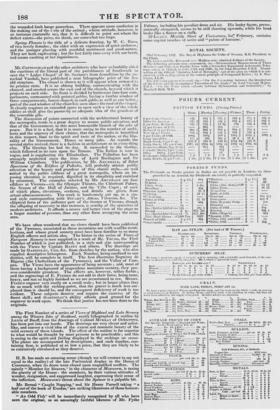Mr. COTTINGIIAM and the other architects who have so laudably
aided the exertions of the liberal part of the parishioners of Southwark to save the " Ladye Chapel" of St. Saviour's from demolition by the pa- rochial Vandals, have published a neat lithographic print of the fine old structure. The chapel is shown as it will appear when restored to its pristine state. It is an oblong building, communicating with the chancel, and erected across the east end of the church, beyond which it projects on each side. Its front is divided by buttresses into four com- partments, surmounted with pointed gables, having a Gothic window of three compartments, lancet-shaped, in each gable, as well as one below; part of the east window of the church is seen above the roof of the chapel. It clearly requires an extended space to open such a view of the whole edifice as shall give the passer-by an adequate idea of the grandeur of the venerable pile.
The discussion of points connected with the architectural beauty of the metropolis, tends in a great degree to arouse public attention, and that of the Government, to this most honourable branch of the arts of peace. But it is a fact, that it is more owing to the number of archi- tects and the urgency of their claims, that the metropolis is beautified in this respect, than to the spirit and taste of the nation, or the libe- rality of the Government. Hence so many jobs. As regards the several styles revived, there is a fashion in architecture as in every thing else. The Grecian has had its day. It succeeded to the Gothic, which followed in its turn upon the Roman. The Italian is now in vogue, and is supplanting the Elizabethan. The Palladian has been strangely neglected since the time of Lord Burlington and Sir William Chambers. The publication, by Mr. ARUNDALE, of Select Specimens of the Edifices of Palladio, will probably attract public attention to the beauty and grandeur of this classic style,-so well siuited to the public edifices of a great metropolis, where an im- posing elevation is required, dignified in its simplicity and enriched by ornament. The examples selected by Mr. ARUNDALE are four edifices at Vicenza-viz. the Olympic Theatre, the Chiericati Palace, the Screen of the Hall of Justice, and the Villa Capri ; of each of which plans, elevations, sections, and details are given, from actual admeasurements. The work is handsomely got up, in a size and style corresponding with STUART'S Athens, Vitruvius, 8r.c. The elliptical form of the audience part of the theatre at Vicenza, though the offspring of necessity in this instance, is worthy of the attention of modern architects. It affords a nearer and better view of the stage to a larger number of persons, than any other form occupying the same area.


























 Previous page
Previous page